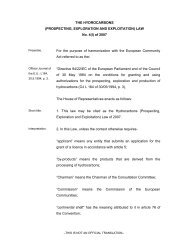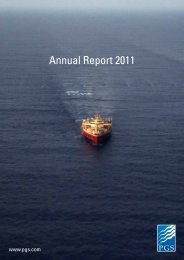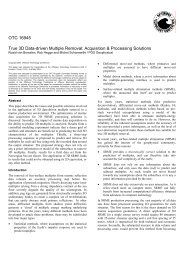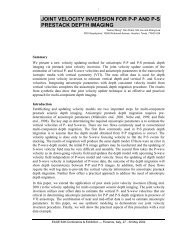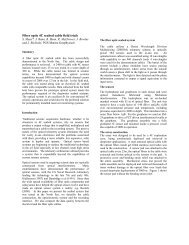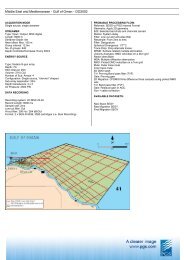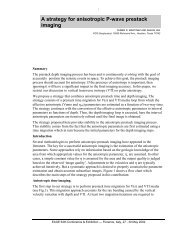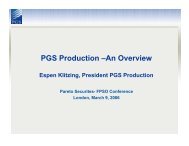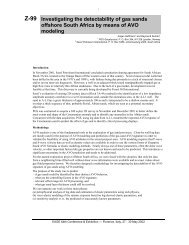Wave Equation PSDM - Petroleum Geo-Services
Wave Equation PSDM - Petroleum Geo-Services
Wave Equation PSDM - Petroleum Geo-Services
You also want an ePaper? Increase the reach of your titles
YUMPU automatically turns print PDFs into web optimized ePapers that Google loves.
A Publication of PGS <strong>Geo</strong>physical Vol. 5 No. 9<br />
October 2005<br />
<strong>Wave</strong> <strong>Equation</strong> Pre-Stack Depth Migration at PGS<br />
Introduction<br />
Pre-stack depth migration (<strong>PSDM</strong>)<br />
of 3D seismic data is a challenging and<br />
complex process. An almost countless<br />
array of <strong>PSDM</strong> solutions can be found<br />
in the literature. Each solution will<br />
pursue an improvement in a specific<br />
geophysical component of imaging<br />
(e.g. the accuracy of steep dips or the<br />
preservation of “true” amplitudes), or<br />
will attempt to overcome the significant<br />
computational costs that have delayed<br />
the entry of <strong>PSDM</strong> into mainstream<br />
processing. As computational<br />
resources become faster and cheaper it<br />
becomes more feasible to use <strong>PSDM</strong> on<br />
larger size 3D data volumes.<br />
Simultaneously, it becomes more<br />
feasible to implement increasingly<br />
sophisticated <strong>PSDM</strong> solutions, thereby<br />
addressing challenges to successful<br />
seismic imaging from increasingly<br />
complex geology.<br />
The industry market for<br />
commercial <strong>PSDM</strong> processing has<br />
matured rapidly during the last decade.<br />
<strong>PSDM</strong> algorithms using Kirchhoff<br />
integral techniques are now routinely<br />
used on large-scale 3D volumes.<br />
Significantly, “wave equation” <strong>PSDM</strong><br />
(WE<strong>PSDM</strong>) algorithms are now being<br />
used on large 3D surveys in the Gulf of<br />
Mexico, and smaller 3D volumes<br />
elsewhere.<br />
WE<strong>PSDM</strong> algorithms use<br />
wavefield extrapolation techniques to<br />
image pre-stack seismic data in depth.<br />
In contrast to most Kirchhoff<br />
implementations, they can naturally<br />
handle “multi-arrivals” or<br />
“triplications”, where multi-pathing<br />
occurs between specific source and<br />
receiver locations. Complex scattering,<br />
focusing and defocusing effects are<br />
implicitly also accounted for.<br />
WE<strong>PSDM</strong> does not make the high<br />
frequency assumptions of Kirchhoffbased<br />
<strong>PSDM</strong> and, therefore, can<br />
produce higher quality images in areas<br />
of complex geology (rapid lateral<br />
variations in velocity). As noted, the<br />
increasingly attractive price<br />
/performance ratios of Linux-based PC<br />
clusters allow the pursuit of more<br />
accurate and more computationally<br />
intensive WE<strong>PSDM</strong> algorithms.<br />
Discussion is given below to the<br />
selection of different WE<strong>PSDM</strong><br />
algorithms for different geological<br />
scenarios.<br />
It is clear that ongoing<br />
developments in WE<strong>PSDM</strong> technology<br />
will see its application to increasingly<br />
larger projects, in a cost effective<br />
manner. From a technical viewpoint,<br />
we will eventually see wavefield<br />
extrapolators being developed that are<br />
capable of handling wave propagation<br />
at all dips in a medium with all arbitrary<br />
lateral velocity variations.<br />
<strong>Wave</strong> <strong>Equation</strong> <strong>PSDM</strong><br />
Fundamentals<br />
The many names given to WE<br />
migration methods are often confusing<br />
Continued on next page<br />
Summary<br />
PGS has invested significant<br />
resources in the development of<br />
wave equation pre-stack depth<br />
migration (WE<strong>PSDM</strong>) routines.<br />
These include Common Azimuth<br />
migration and shot migrations at<br />
increasing levels of sophistication:<br />
Gazdag Phase Shift, Split-Step<br />
Fourier, and Finite Difference<br />
methods. Gazdag Phase Shift and<br />
Split-Step Fourier are highly<br />
efficient extrapolation methods<br />
suitable for mild lateral velocity<br />
variations. Finite Difference<br />
methods are more accurate for<br />
strong velocity changes, and may<br />
be classified into explicit and<br />
implicit approaches. Each<br />
technique presents inherent merits<br />
and challenges with respect to<br />
efficiency and cost. The critical<br />
virtue is that a flexible range of<br />
WE<strong>PSDM</strong> solutions are available<br />
to be customized to the demands<br />
of any imaging project. In other<br />
words, the solution is matched to<br />
the complexity of the earth model<br />
and the geophysical objectives.<br />
When 3D acquisition is<br />
appropriately parameterized to<br />
enable precise 3D data<br />
regularization, and an accurate 3D<br />
velocity model can be constructed,<br />
WE<strong>PSDM</strong> will provide the most<br />
sophisticated and accurate<br />
imaging solutions available.
TechLink October 2005 Page 2<br />
<strong>Wave</strong> <strong>Equation</strong> <strong>PSDM</strong><br />
Fundamentals<br />
Continued from Page 1<br />
because they may refer to the domain in<br />
which the process occurs (e.g.<br />
“frequency-wavenumber”), the manner<br />
in which the data is organized during<br />
the process (e.g. “shot record” or “shotgeophone”),<br />
the methodology used (e.g.<br />
“survey sinking” or “reverse time”) or<br />
the type of extrapolation used (e.g.<br />
“explicit finite difference”).<br />
Irrespective of the many types of<br />
WE<strong>PSDM</strong> implementations, all<br />
migrations consist of the following two<br />
elements:<br />
• The solution of a differential equation<br />
(the wave equation or its equivalent),<br />
and<br />
• The application of an imaging<br />
condition.<br />
In terms of both accuracy and cost,<br />
the extrapolator used is the most<br />
defining issue. The most accurate<br />
extrapolator is that used by reverse time<br />
migration, which is a “two way”<br />
solution. Two way extrapolation can<br />
handle multiples, is able to image high<br />
dip and turning waves, provides better<br />
(relative) amplitudes preservation and<br />
better accommodates numerical noise<br />
and imaging artefacts. Unfortunately,<br />
two way extrapolators are about an<br />
order of magnitude slower than one<br />
way extrapolators, so all current<br />
commercial WE<strong>PSDM</strong> algorithms use<br />
one way (downward) extrapolators.<br />
One way extrapolators cannot handle<br />
multiples (they must be removed prior<br />
to imaging), are restricted to dips less<br />
than 90°, and will accommodate lateral<br />
velocity variations according to their<br />
complexity (and therefore cost). In<br />
order of increasing complexity,<br />
examples include Gazdag phase shift,<br />
Split-Step Fourier, phase shift plus<br />
interpolation, and (implicit or explicit)<br />
finite difference.<br />
The two most<br />
common one way<br />
extrapolation<br />
implementations are<br />
“common shot” and<br />
“survey sinking”<br />
implementations.<br />
Common shot domain<br />
techniques extrapolate<br />
the shot and receiver<br />
w a v e f i e l d s<br />
independently, and<br />
obtain an image for<br />
each shot by comparing<br />
the two wavefields at<br />
each spatial location<br />
and depth. Plane wave<br />
techniques (e.g.<br />
“delayed shot”) are a cost-saving The PGS <strong>Wave</strong> <strong>Equation</strong><br />
implementation of common shot <strong>PSDM</strong> Portfolio<br />
techniques that migrate several shots PGS currently offers five<br />
simultaneously. Survey sinking WE<strong>PSDM</strong> solutions contained in three<br />
techniques (such as common or narrow routines in its Cube Manager<br />
azimuth WE<strong>PSDM</strong>) simultaneously<br />
extrapolate both the shot and receiver<br />
wavefields, effectively simulating the<br />
wavefield as if it was recorded at each<br />
extrapolated depth (thus the “survey<br />
sinking” name). The output image at<br />
each spatial location is obtained when<br />
the extrapolated shot and receiver are<br />
collocated (i.e. zero offset and time).<br />
Common shot implementations are the<br />
most accurate WE<strong>PSDM</strong> solutions, and<br />
form the majority of the PGS<br />
WE<strong>PSDM</strong> portfolio.<br />
Numerous wavefield extrapolation<br />
techniques are available within the PGS<br />
WE<strong>PSDM</strong> portfolio. The choice of<br />
which to use is driven by: 1. The<br />
complexity of the velocity model,<br />
notably the lateral variability, and 2.<br />
The computational speed requirements<br />
of the particular project. The benefits<br />
of a large portfolio of WE<strong>PSDM</strong><br />
solutions are flexibility and efficiency,<br />
as illustrated in Figure 1.<br />
TM<br />
Figure 1: The variety of wavefield extrapolators available<br />
within the PGS WE<strong>PSDM</strong> portfolio. Gazdag phase shift<br />
migration is exact for no lateral velocity variation, and is<br />
the fastest available option (much faster than Kirchhoff).<br />
Finite difference migration provides the most accurate<br />
solution in complex velocity media (including VTI<br />
anisotropy), but is also the most computationally expensive.<br />
PGS does provide the ability to select the most efficient<br />
extrapolation solution at each depth step, constrained by<br />
the lateral variability in the velocity model at the output<br />
depth step.<br />
processing system:<br />
1. A fast Common Azimuth WE<strong>PSDM</strong><br />
that is particularly suitable for typical<br />
marine seismic geometries, and for<br />
early iterations in depth imaging<br />
when the velocity model is being<br />
refined. Lateral velocity variations<br />
are elegantly handled, as is the phase<br />
correction required at each depth step.<br />
2. A unique, multi-algorithm Adaptive<br />
WE <strong>PSDM</strong> that efficiently images<br />
geology where the overburden has<br />
relatively mild velocity variation.<br />
The strategy involves the automated<br />
selection of the most appropriate<br />
algorithm based on the measured<br />
velocity complexity at each depth<br />
step (refer also to Figure 1). Thus,<br />
Gazdag Phase Shift and Split-Step<br />
Fourier methods are used where mild<br />
velocity variation allows. An<br />
inline/cross-line splitting Implicit<br />
Finite Difference solution, with phase
Page 3 A Publication of PGS <strong>Geo</strong>physical<br />
correction, is applied in the case of<br />
more complex velocity variation. Our<br />
adaptive approach is also available in<br />
shot and plane wave modes, and<br />
incorporates WKBJ corrections in the<br />
wavefield extrapolation for correct<br />
amplitude preservation. The<br />
application may also be run entirely in<br />
single-algorithm mode for each of the<br />
three respective algorithms.<br />
3. An Explicit Finite Difference<br />
WE<strong>PSDM</strong>. This is the PGS flagship<br />
WE<strong>PSDM</strong> implementation, and uses<br />
an innovative “constrained” operator<br />
design for downward extrapolation<br />
that ensures stability, efficiency and<br />
high dip accuracy. The<br />
implementation handles isotropic and<br />
VTI anisotropic velocity fields, steep<br />
dips, and is available in both full shot<br />
and plane wave modes. Efficiency<br />
measures inherent in the<br />
implementation include the ability to<br />
handle rectangular bins and the<br />
adaptive design of variable step sizes.<br />
Of significance to the extraction of<br />
reservoir parameters, this solution<br />
includes an imaging condition that<br />
extracts data reflectivity.<br />
Naturally, the accuracy of the 3D<br />
velocity model used for WE<strong>PSDM</strong> is<br />
critical, and represents a critical<br />
challenge to any imaging success. PGS<br />
has the ability to generate (reflection)<br />
angle gathers for velocity model<br />
updates, and the ability to perform<br />
velocity scanning for velocity model<br />
updates, particularly in sub-salt areas.<br />
Figure 2 illustrates an explicit<br />
finite difference WE<strong>PSDM</strong> application<br />
to the well-known SIGSBEE2A<br />
synthetic model.<br />
Figure 3 illustrates the<br />
improvements possible by replacing<br />
Kirchhoff <strong>PSDM</strong> with explicit finite<br />
difference WE<strong>PSDM</strong>, as applied to a<br />
Continued on next page<br />
Figure 2: The explicit finite difference <strong>PSDM</strong> enables very accurate imaging below salt<br />
structures, as illustrated with this SIGSBEE2A example. Subtle faults and sub-salt structures<br />
are evident, and image focus is excellent in all spatial locations. Thus, WE<strong>PSDM</strong> is proven to<br />
have significant value in locations of complex velocity variation.<br />
Figure 3: Kirchhoff <strong>PSDM</strong> (left) vs. Explicit Finite Difference WE<strong>PSDM</strong> (right) in the Gulf of<br />
Mexico. Note the benefits of WE<strong>PSDM</strong> for imaging sedimentary features on the flanks of the<br />
salt and below the salt.<br />
Figure 4: Isotropic (left) vs. Anisotropic (right) Explicit Finite Difference <strong>PSDM</strong> comparison<br />
of images from the Marmousi model dataset. Incorporation of VTI anisotropy parameters<br />
allows superior focusing of events, notably in the upper half of the section.
TechLink October 2005 Page 4<br />
The PGS <strong>Wave</strong> <strong>Equation</strong><br />
<strong>PSDM</strong> Portfolio<br />
Continued from Page 3<br />
real dataset is from the Gulf of Mexico.<br />
Significant improvements were<br />
achieved in terms of image resolution<br />
and clarity.<br />
Finally, Figure 4 illustrates the<br />
benefits of VTI anisotropic capability<br />
when the explicit finite difference<br />
WE<strong>PSDM</strong> is applied to the well-known<br />
Marmousi synthetic model.<br />
Optimum Acquisition<br />
Considerations for WE<strong>PSDM</strong><br />
All “wave equation” processes<br />
assume that the input dataset is<br />
uniformly sampled. As any 3D<br />
streamer acquisition survey will<br />
inherently involve variable vessel<br />
trajectories, streamer feathering, and<br />
variable sea state, pre-stack 3D data is<br />
by nature irregularly sampled. Aside<br />
from lower computational cost,<br />
Kirchhoff migration methods have been<br />
the historical method of choice because<br />
they are far more robust in their ability<br />
to accommodate irregular data. The<br />
solution to this dilemma is effective<br />
data “regularization”. 3D<br />
regularization is a significant area of<br />
C O N T A C T<br />
PGS <strong>Geo</strong>physical<br />
London<br />
Tel: 44-1932-260001<br />
Fax: 44-1932-266465<br />
Oslo<br />
Tel: 47-67-52-6400<br />
Fax: 47-67-52-6464<br />
Houston<br />
Tel: 1-281-509-8000<br />
Fax: 1-281-509-8500<br />
Singapore<br />
Tel: 65-6735-6411<br />
Fax: 65-6735-6413<br />
© 2005 <strong>Petroleum</strong> <strong>Geo</strong>-<strong>Services</strong>. All Rights Reserved<br />
ongoing research within the industry<br />
and academia, and has a history as<br />
challenging as that of the development<br />
of imaging methods themselves.<br />
Whilst outside the scope of this<br />
discussion, it can be briefly observed<br />
that regularization methods have a full<br />
spectrum of technical complexity vs.<br />
cost efficiency. Compromises in the<br />
integrity of regularization processing<br />
will translate to compromises in the<br />
integrity of the final imaging result. In<br />
the most sophisticated scenario, Fourier<br />
regularization is not theoretically<br />
limited to plane events or a limited<br />
number of dips, does not use a<br />
geophysical model to describe the input<br />
data, and provided that the input data is<br />
not unacceptably aliased, can be<br />
considered as an “exact” process.<br />
Therein lays an assumption with<br />
implications for the ideal 3D<br />
acquisition platform. High Density 3D<br />
(HD3D) acquisition presents the<br />
acquisition platform that minimizes<br />
data aliasing in any direction, and can<br />
be customized to satisfy specific<br />
assumptions about cross-line aperture<br />
or target illumination, as demanded by<br />
other high-end processing algorithms.<br />
When allowed to work successfully,<br />
Fourier regularization will use a<br />
parametric inversion to output the data<br />
to a perfectly uniform data grid, as<br />
demanded by the user. Properly<br />
sampled (HD3D) data will present the<br />
best platform for regularization, which<br />
in turn will present the optimum<br />
platform for the successful application<br />
of WE<strong>PSDM</strong>.<br />
Figure 5: Dense spatial sampling of the reflected wavefield is provided by HD3D acquisition<br />
to avoid aliasing and ensure the successful application of regularization and WE<strong>PSDM</strong><br />
technology. The “dark” regions on the wavefront shown (from a single shot in a complex<br />
model, as produced by 3D ray tracing) are “multi-arrivals”. A specific receiver location at<br />
the surface will receive three discrete arrivals from the same wavefront. This observation<br />
reinforces the value of dense sampling for accurate reconstruction of the target during<br />
(WE<strong>PSDM</strong>) imaging.<br />
For Updates on PGS Technological Advances, visit www.pgs.com<br />
More TechLinks at www.pgs.com/techlink



